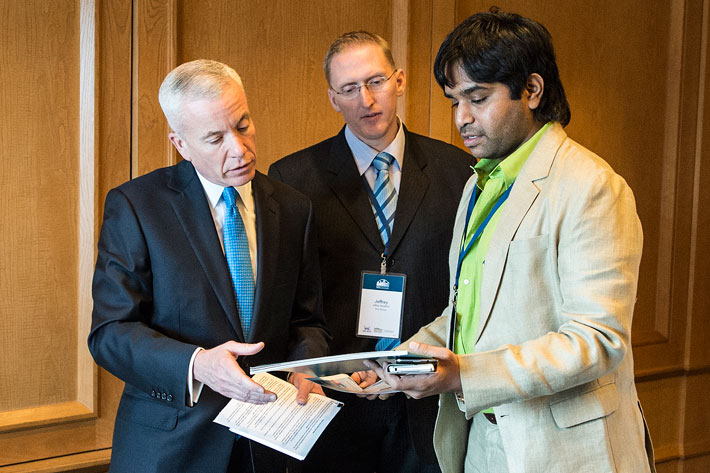By Julia Parmley
The flow of global real estate capital is more diverse than ever before—and so are the risks. While there is still a high degree of confidence and predictability in particular real estate markets, investors are increasingly interested in smaller economies and secondary markets, and experts warn current historically-low capitalization rates may not last.
These risk and rewards—and the rapid globalization of real estate capital flow—were discussed at the George Washington University’s inaugural Global Real Estate Conference, “Where Does the Smart Capital Flow?” hosted by the GW School of Business Center for Real Estate and Urban Analysis (CREUA) and presenting sponsor VIVA Group on March 26.
The conference, held in New York’s Financial District, brought together academics and practitioners in the field of global real estate capital from China, India, Mexico, The Netherlands, Germany and from across the United States for a critical face-to-face discussion about the opportunities and challenges associated with the provision of global capital.
Panelists included Edward Forst, president and chief executive officer at Cushman & Wakefield; Guy Metcalfe, managing director and chairman, Global Real Estate Investment Banking at Morgan Stanley; and leadership from other major firms, such as Baupost, CBRE, Jamestown, Newmark Grubb Knight Frank and global organizations such as FIABCI and RICS.
School of Business faculty panelists included Tom Geurts, associate professor of real estate and finance, and Reid W. Click, director of the school’s Center for International Business Education and Research (CIBER).
Speakers addressed a wide range of issues in the field, including tax reform of foreign and domestic investment in U.S. real estate, the strength and security of investing foreign capital in the United States, increasing investment interest in secondary markets with new risk profiles, the importance of market transparency and the need of finding reliable local partners and concerns about market volatility with changing political structures and currency values.
“There’s a theoretical side of capital flow and a practical application of it, and both are needed for a long-term vision,” said Dr. Geurts. “The conference provided a top-down approach to capital flow and a theoretical framework for practitioners. Practitioners are dealing with more clearly-defined issues like risk management and partnership relations on a daily basis, but sometimes they need to take a step back and see the big picture, and that’s what we were able to accomplish with this conference.”
Investing in indirect and direct real estate has been globalizing at a rapid pace during the past two decades, which creates both tremendous opportunity and increased chance of unpredictability. According to panelists, a growing number of capital providers, portfolio managers and developers are now pursuing alternative product types, including senior housing, student housing and rental properties, and there is increased capital flowing into emerging investment areas like India and Colombia. In countries such as these, there are high return opportunities; however, they come with higher risks that can be mitigated by having reliable local partners.
Panelists also discussed the broad financial changes in Europe and their potential effects on capital flow. Volatility regarding Greece’s debt crisis, for example, has some investors investing more cautiously than before.
But despite the changing landscape, there remains a sense of optimism about the manageability of risks in the real estate market. There is still a strong demand to invest in U.S. real estate—particularly in San Francisco and New York—and investors are now looking to expand capital flow in dynamic regions like India, Singapore and Indonesia.
Monty Thakur, owner and director of VIVA Group, said the conference was an opportunity to strengthen the company’s relationship with GW and expand VIVA’s association with U.S. partners. One of the largest land aggregators in Mumbai, India, VIVA Group is a multifaceted business conglomerate involved in retail, logistics, media, education, hospitality and other portfolios.
“This conference was a good opportunity to expose VIVA as a company and for us to be exposed to different ideas and people,” said Mr. Thakur. “India today is dependent on foreign capital for its development and growth and most of the capital is coming from the U.S. market, so the topic of global real estate capital flow is a very important one for us.”
VIVA Group is a member of CREUA’s advisory board and for the past several years has provided students in GWSB’s international case study program with unique on-the-ground exposure to development projects in India.
The CREUA advisory board also played a critical role in the conference by helping to secure panelists from leading corporations, creating valuable networking opportunities for attendees.
“One of the repeated statements during the conference has been that when investing abroad one has to have a reliable partner,” said Dr. Geurts. “By organizing this conference, the GW School of Business is helping to facilitate these important connections in the real estate business sector.”
Additional conference sponsors included CIBER, RICS, FIABCI, Taconic Investment Partners, First Wall Street, Cushman & Wakefield, Institutional Real Estate, Inc., and SNL Real Estate.


